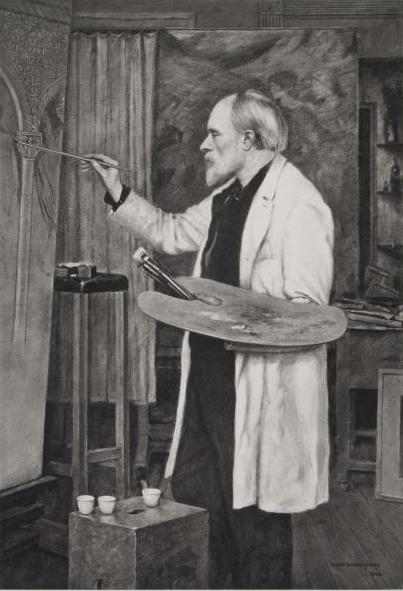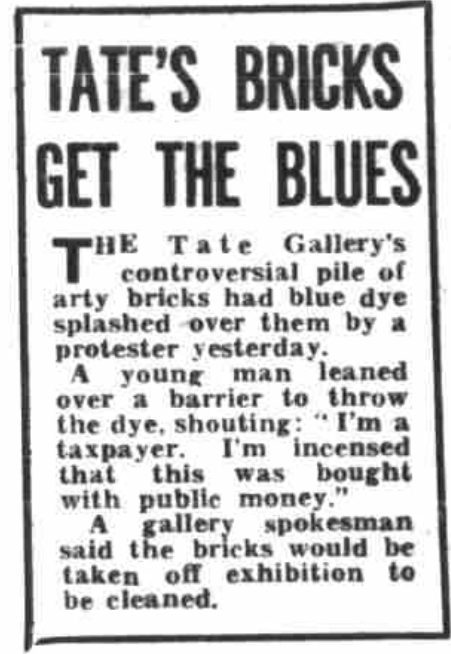London: a hotbed of edgy art and steaming controversy. Mush the two together, and you've got yourself some of the most contentious exhibitions the world ever saw...
1. Constable and Turner scrap over a red blob, Royal Academy, 1832

"He has been in here and fired a gun": John Constable’s angry words on seeing JMW Turner's last minute change to a painting at the Royal Academy's exhibition in 1832. Constable had spent 15 years working on his own painting for the show, The Opening of Waterloo Bridge, but when Turner saw how Constable's work overshadowed his own painting, Helvoetsluys, he decided to outdo him by adding a red buoy (THE NERVE!) to his seascape, seizing attention away from the Constable painting.
Most critics preferred the Turner and spoke poorly of the Constable work hanging next to it, with the Morning Herald critic commenting that, "Mr Constable appears to think he is a Turner." Constable was furious, and the already difficult relationship between the two painters turned into outright hatred.
2. Pre-Raphaelite refuses to rub out his genitals — withdraws instead, Pall Mall Galleries, 1870

When Edward Burne-Jones exhibited his painting of the mythological characters Phyllis and Demophoon at the 1870 Old Watercolour Society exhibition, it caused the greatest scandal in the society's history, due to its portrayal of male full frontal nudity in the character of Demophoon. The resemblance of the woman's face to the artist Maria Zambaco, with whom Burne-Jones had been having a relationship, was also controversial: the previous year, the police had been called to a conflict between Burne-Jones and Zambaco in Little Venice where she had tried to kill herself with an overdose of laudanum.
Following these controversies, the Old Watercolour Society asked Burne-Jones to make some changes and disguise the male genitals in the painting. He refused, and instead withdrew his painting from the exhibition and left the society.
3. New paintings by dead artists, New Bond Street, 1871

Georgiana Houghton's 1871 exhibition split critical opinion. One reviewer called it "the most astonishing exhibition in London at the present moment", another condemned it with the words, “We should not have called attention to this exhibition at all, did we not believe that it will disgust all sober people with the follies which it is intended to advance and promote."
Why so divisive? It was because Houghton was a Victorian spiritualist who claimed to be able to communicate with the dead, and made paintings which she alleged were created with the spirits of deceased artists, including Titian and Correggio. She staged her 1871 show at the New British Gallery in New Bond Street, but the show was highly controversial, partly due to scepticism about Houghton's claims to have channelled the dead artists, and partly due to the abstract style of the paintings themselves. Another critic described the show as sad and ludicrous, and as Houghton had invested much of her own money into it, weak ticket sales meant she was almost bankrupted as a result.
4. Manet and the Post-Impressionists, Grafton Galleries, 1910

The 1910 exhibition of notable Post-Impressionist works raised hackles in the art world. "Why talk of the sincerity of this rubbish?" seethed the critic Charles Ricketts. It was considered an outrage by members of the press, who compared it to acts of violence and terror, and even made personal attacks on the Roger Fry, the exhibition organiser, and his wife Helen: Desmond McCarthy recalled that “people called him mad, and reminded others that his wife was in an asylum." However, the media fury ironically led to huge public interest with over 25,000 people ultimately attending the show. Virginia Woolf would later say that the opening of the exhibition marked a pivotal moment in modernism: "On or about December 1910 human character changed."
5. The suffragettes turn violent, 1914

In early 1914, the art galleries of London saw a number of political protests by suffragettes, who were demonstrating for women’s voting rights, as well as making a statement against the male dominance within these institutions. These protests included Mary Wood’s attack on John Singer Sargent's portrait of Henry James at the Royal Academy; Mary Richardson's on Velasquez's Rokeby Venus at the National Gallery; and Anne Hunt's on Millais' portrait of Thomas Carlyle at the National Portrait Gallery.
Wood's slashing of the Sargent painting occurred on a busy day at the RA's summer exhibition: the Daily Graphic described the event as having "startled a fashionable Royal Academy crowd out of its decorum." The crowd turned on Wood, and when one man tried to speak out in her support, he was assaulted by another man in the gallery.
6. Winston Churchill has a hissy fit, Westminster Hall, 1954

Only exhibited once and never again, due to the controversy over the approach to the subject, Graham Sutherland's portrait of Winston Churchill was publicly displayed at Westminster Hall in the Houses of Parliament in a ceremony also filmed by the BBC. It was hugely divisive, both with critics and with other politicians: some called it "beautiful" while others regarded it as "disgusting". Churchill and his wife Clementine both hated the work and in later years it was revealed they had had it burned, leading to further controversy and Sutherland describing its destruction as a form of vandalism.
7. Anger over some bricks, Tate, 1976

One of the most surprising things about the controversy over the 1976 exhibition at the Tate of Carl Andre’s brick work, Equivalent VIII? That the work had been on display many times since its purchase in 1972 without causing any fuss. Yet its 1976 exhibition led to press attacks and attempted vandalism by a member of the public who threw blue dye over it. The Tate was also attacked by people for the amount of money it had spent on the work. The media expressed outrage but also revelled in it: as the New York Times said, the controversy had "given the newspapers here their best time in weeks", with the Daily Mirror sending reporters out to building sites to challenge people to recreate Andre’s work in brick form.
8. A disturbing painting of a serial killer, Royal Academy, 1997

One of the most infamous exhibitions in British art history, and the defining show of the Young British Artists, Sensation took place at the Royal Academy and featured some of the most characteristic YBA works, including Damien Hirst's shark in formaldehyde.
The most notorious work, however, was Marcus Harvey's Myra, based on a photograph of Myra Hindley, in which the work was created through a composite of repeated images of a child’s handprint. This led to public protests and a few of the windows at the exhibition venue being smashed. Four members of the RA resigned due to its inclusion in the show, and it was vandalised by two different artists, leading to the use of security guards for the rest of the exhibition.
9. A naked pillow fight on a £2.5m bed, Tate, 1999

The 1999 Turner Prize nominees included Tracey Emin for her infamous work My Bed, consisting of her actual bed covered in personal items, including her underwear and empty vodka bottles. October 1999 saw a stream of newspaper stories focusing on the work and the divisive reaction it provoked, with Adrian Searle of The Guardian describing it as "an endlessly solipsistic, self-regarding homage". The storm around the work led to a later intervention by two performance artists, Yuan Chai and Jian Jun Xi, who climbed on the bed half naked and began having a pillow fight. They were arrested but ultimately released without charge. The 1999 prize would ultimately be won by Steve McQueen, but My Bed would remain a notorious work, and it was later sold at auction in 2014 for £2.54 million.
10. A guy having a break down, Oxford Street, 2001
A former C&A branch seems a surprising place to hold an art show. Yet it was at one of these in Oxford Street in 2001 that the artist Michael Landy staged his controversial work Break Down, during which he destroyed every one of his 7,227 belongings. The only thing had had left was the blue boiler suit he wore as he destroyed all his things. Public reaction was divided: some admired Landy's commitment to the idea, others were shocked at the idea of so much waste. James Lingwood, who commissioned the work, told the BBC that observers on Oxford Street watching Landy's destruction take place were "deeply unsettled – and sometimes appalled" by what they were seeing.
By Jane Alexander



